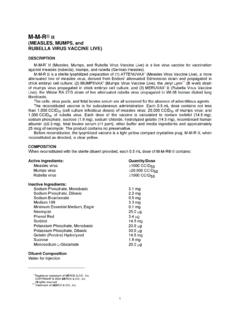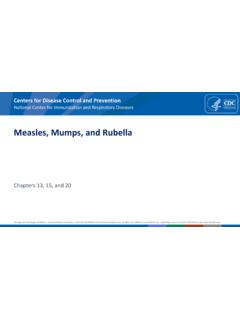Transcription of Chapter 20: Rubella; Epidemiology and Prevention of ...
1 Rubella30120 The name rubella is derived from Latin, meaning little red. rubella was initially considered to be a variant of measles or scarlet fever. It was not until 1814 that it was first described as a separate disease in the German medical literature, hence the common name German measles. In 1914, Alfred F. Hess postulated a viral etiology based on his work with monkeys. Following a widespread epidemic of rubella infection in 1940, Norman Gregg, an Australian ophthalmologist, reported in 1941 the occurrence of congenital cataracts among infants born following maternal rubella .
2 This was the first published recognition of congenital rubella syndrome (CRS). rubella virus was first isolated in 1962 by two independent groups, Paul D. Parkman and colleagues and Thomas H. Weller and Franklin A. Neva. The first rubella vaccines were licensed in 1969. In 1971, a combined measles, mumps, and rubella (MMR) vaccine was licensed for use in the United States. In 2005, a combination measles, mumps, rubella , and varicella (MMRV) vaccine was Virus rubella virus is the sole member of the genus Rubivirus, in the family Matonaviridae.
3 It is an enveloped virus with a single-stranded RNA of positive polarity and has a single antigenic type. Pathogenesis Following respiratory transmission, the virus replicates in the nasopharynx and regional lymph nodes. In a pregnant woman, placental infection occurs during viremia and may lead to transplacental fetal infection. Fetal damage occurs through destruction of cells, as well as disruption of cell division. Fetal infection often results in a persistent infection typically leading to hearing impairment and ocular and cardiovascular abnormalities.
4 Clinical Features Acquired rubella The average incubation period of rubella is 14 days, with a range of 12 to 23 days. Symptoms are often mild, and up to 50% of infections may be subclinical or inapparent. In young children, rash is usually the first symptom. In older children and adults, there may be a 1- to 5-day prodrome with low-grade fever, malaise, lymphadenopathy, and upper respiratory symptoms preceding the rash. Lymphadenopathy may begin a week before the rash and last several weeks. The rubella rash Tatiana Lanzieri, MD; Penina Haber, MPH; Joseph P.
5 Icenogle, PhD, MS; and Manisha Patel, MD, MSRubella Pathogenesis Respiratory transmission of virus Replication in nasopharynx andregional lymph nodes Possible transplacental infectionof fetus during viremia Hearing impairment andocular and cardiovascularabnormalities may resultRubella Clinical Features Incubation period 14 days(range, 12 to 23 days) Rash first symptom inyoung children Prodrome with low-grade fever,malaise, lymphadenopathy, andupper respiratory symptomsbefore rash in older childrenand adults Maculopapular rash 14 to 17days after exposure Arthralgia common inadult womenRubella Virus Rubivirus RNA virus One antigenic typeRubella Initially thought to be variant ofmeasles or scarlet fever First described as distinctdisease in German literature in1814 (hence German measles ) congenital rubella syndrome (CRS)
6 First described 1941 rubella virus isolated in 1962 2021302 rubella 20is maculopapular and occurs 14 to 17 days after exposure. The rash usually occurs initially on the face and then progresses from head to foot. It lasts about 3 days and is occasionally pruritic. The rash is fainter than a measles rash, does not coalesce, and is often more prominent after a hot shower or bath. Postauricular, posterior cervical, and suboccipital nodes may be involved. Arthralgia (joint pain) and arthritis are rare in children and adult males but occur frequently in adult women.
7 Joint symptoms tend to occur at about the same time or shortly after the rash appears and may last for up to 1 month. Fingers, wrists, and knees are often affected. Chronic arthritis is rare. Other symptoms of rubella include conjunctivitis, testalgia, or orchitis. Small, red (Forschheimer) spots may be noted on the soft palate but are not diagnostic for Complications of rubella are rare. Hemorrhagic manifestations occur in approximately 1 per 3,000 cases. These manifestations may be secondary to low platelets and vascular damage, with thrombocytopenic purpura being the most common.
8 Gastrointestinal, cerebral, or intrarenal hemorrhage may also occur. Effects may last from days to months, and most patients recover. Encephalitis occurs in 1 in 6,000 cases and may be fatal. Additional rare complications include granulomas in persons with primary immune deficiencies, orchitis, neuritis, and a late syndrome of progressive panencephalitis. congenital rubella syndrome (CRS) Prevention of congenital rubella syndrome (CRS) is the main objective of rubella vaccination programs. Infection with rubella virus is most consequential in early gestation and can lead to miscarriages, stillbirths, and severe birth defects in infants.
9 The risk of CRS is highest when a woman acquires rubella during the first 12 weeks of gestation. congenital infection with rubella virus can affect many organ systems. congenital rubella syndrome includes a constellation of birth defects, such as deafness, eye abnormalities (cataracts, glaucoma, retinopathy, microphthalmia), and congenital heart disease. Laboratory TestingMany rash illnesses can mimic rubella infection, so clinical diagnosis is unreliable. Acute or recent rubella infection can be confirmed by detection of rubella virus by polymerase chain reaction (PCR), a significant rise in rubella specific immune globulin (Ig)G antibody from paired acute- and convalescent-phase sera, or the presence of rubella -specific IgM antibody.
10 rubella Complications Encephalitis 1 in 6000 cases Hemorrhagic manifestations( , thrombocytopenicpurpura) 1 in 3000 cases Other rare complications granulomas, orchitis, neuritis,progressive panencephalitisCongenital rubella syndrome (CRS) Prevention of CRS is themain objective of rubellavaccination programs May lead to miscarriages,stillbirths, and birth defects Birth defects may includedeafness, eye abnormalities,and congenital heart diseaseRubella30320 The optimal time for serum collection for IgM detection is 5 days after onset of symptoms (fever and rash).















